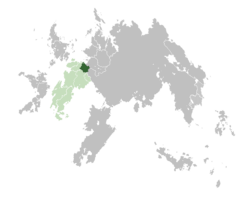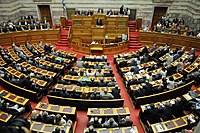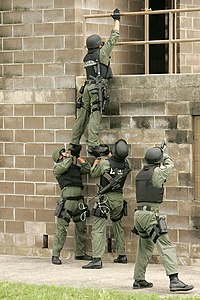Brilliania
This article is incomplete because it is pending further input from participants, or it is a work-in-progress by one author. Please comment on this article's talk page to share your input, comments and questions. Note: To contribute to this article, you may need to seek help from the author(s) of this page. |
Federal Republic of Brilliania Errepublika Federala Berilinakoren (Brillian language) Berílet szövetségi köztársaság (Iparinan language) | |
|---|---|
Coat of arms
| |
| Motto: Mantendu egingo dugu We will maintain | |
| Anthem: Icsaropena Iparinan: Remény) | |
 Location of Brilliania (dark green) in Cardia (green) | |
| Capital | Szaranegertu |
| Largest | Marina Szantua |
| Official languages | Brillian, Iparinan |
| Religion | Marism |
| Demonym(s) | Brillian |
| Government | Federal presidential republic |
| Endrike Karagori (BM) | |
| Alcsai Vikuna (AP) | |
| Sabin-Heren Incsaurpe (BM) | |
• Speaker of the National Assembly | Yuli Leiszaran (AP) |
| Legislature | National Assembly |
| Independence from Cornicae 1943 | |
• Unification of Brillian territories | 1180 |
• Recodification of Brillian paganism | 1334 |
• Cornice occupation | 1605 |
• Some other kind of uprising | 1822 |
• Askatasuna Movement | 1943 |
• Millenium Revolution | 2000 |
| Population | |
• 2018 census | 18,792,090 |
| GDP (PPP) | 2018 estimate |
• Total | $629,422,262,460 |
• Per capita | $33,494 |
| GDP (nominal) | 2018 estimate |
• Total | $536,983,971,750 |
• Per capita | $28,575 |
| Gini (2016) | medium |
| HDI (2017) | very high |
| Currency | Brillian Florrin (EBF) |
| Time zone | UTC0 |
| Date format | yyyy-mm-dd |
| Driving side | right |
| Calling code | +48 |
| ISO 3166 code | EB |
| Internet TLD | .eb |
Brilliania (Brillian: Berilinako, Iparinan: Beriliország), officially the Federal Republic of Brilliania, (Brillian: Errepublika Federala Berilinakoren, Iparinan: Berílet szövetségi köztársaság) is a sovereign state in northeastern Cardia, bordered by the Karsk Sea to the north and the nations of Vetonia to the west, Dulebia to the east and Finium to the south. The capital city is Szaranegertu, which is administered as a province, with the largest city being Marina Szantua. The largest sectors of the Brillian economy include information technology, services and manufacturing. Over 30% of its total area are forested, and the nation enjoys a moderate sea climate. For a part of its history, it was a part of Cornicae resulting in major oppression of the native religion Marism.
In the aftermath of the Proclamation of Duress in Cornicae, the Brillian revolutionary government located in Mascylla called for an uprising against the Cornice government, sparking the Askatasuna Movement and resulting in an increase of the controversial morality tax instituted by High King Peter X. The tax increase resulted in large revolts and the foundation of paramilitary forces directly responsible for several high-profile attacks on Cornice authorities in Brilliania, combined with the revolutionary government proclaiming sovereignity over both Brilliania and Iséropűsz.
The nation, which is administered as a federal presidential republic with a population of 18,792,090 citizens divided in 6 provinces, mostly consists of the isolated Brillian-speaking Brillian people. Minorities include the Iséropűszans from the southeastern region of Iséropűsz and Rodenians and Iverdorians in areas close to the border with Vetonia.
Brilliania is a developed country with a high-income service-based economy. It ranks highly in the Human Development Index. Although recent governments have prioritized the increasement of social security programmes, there is a high level of disparity between rural and urban areas.
History
Prehistory
Kingdom (xxx - 1605)
Cornica
Brillian Salvationism
Since the start of repression against the longstanding Marist tradition, most Marists have attempted resettlement in the heritage nation of their religion. In 1904, under leadership of Innigo Alveri, the concept of Brillian Salvationism was codified and included the struggle and resistance for the total independence of the Brillian state under the values of Mari. The Cornice royal government strongly disapproved of the development and often used extreme means such as forced exile and pogroms against the nationalists, eventually resulting in widespread resentment by the Brillian populace. A protest in 1911 culminated in the failed Rebellion of xxx, which resulted in a massacre.
Republic under the First Constitution
Republic under the Second Constitution
Millenium Revolution
In 1999, massive protests were sparked after an incident in southern Martirien Herria involving the death of 16-year old student Marin Juhász during anti-governmental protests. In the upheaval caused by the incident, the governing National Appeal lost most of its popularity and was disgraced. The protestors demanded the resignation of the entire Ecsebarrea II Cabinet and the decreasal of the size of Ercainca. After several months of intensive protests, Ecsebarrea dissolved his government and resigned, calling for new elections which were won by the Marist Union in a landslide. The Marist Union, together with all remaining parties except the National Appeal, nominated the technocratic independent politician Ilun Leszaon as Prime Minister. The Leszaon Cabinet was formed for the sole reason of forming a constitutional drafting committee, resulting in a constitutional referendum in 2002.
Republic under the Third Constitution
Brilliania started the transition to its third constitution in 2002, after the approval of the new Constitution of the Republic by a constitutional referendum. The Third Constitution introduced points which were widespread in other nations but not yet implemented in Brilliania, including the right to divorce and the decriminalization of homosexual activities, while also abandoning its policy of relative neutrality in favour of increased international co-operation with states in Hallania and Cardia. Another major instrument of reform was the Charter of the Republic, which introduced provisions for autonomisation of the state and ended the unitary state model in Brilliania in favour of federalism. A third charter, the Economic Instrument of Reform, resulted in the revitalisation of the Brillian economy by ending state control of the economy. With the removal of governmental control of the economy, the economy initially suffered from severe recessions. The privatisation of the postal service, amongst others, resulted in an internal coup within the Marist Union, causing its leader Sabin-Heren Incsaurpe to take over as Prime Minister. Since then, the republic has enjoyed political liberties and a healthy political culture which is marked by the commonality of inter-party co-operation.
Geography
Climate
Environment
Politics and Government
The Republic of Brilliania is administered as a federal presidential republic governed by the framework laws defined in the Third Constitution of the Republic supplemented with the Book of Administrative Law, with the National Assembly serving as national representation. Amendments to either the Constitution or the Book of Administrative Law must be approved by 60% of lawmakers and by a majority of the Brillian populace in an amendemental referendum. 200 members of the National Assembly, the supreme lawmaking authority, are elected every 4 years using party-list proportional representation in a single national list. The highest role in Brillian politics is the First Citizen (Lehendahiritar), which is elected directly by the electorate using the two-round system. The current First Citizen is Endrike Karagori, representing the Marist Union. He was inaugurated on 1 February 2019, after being elected on 26 January 2019 by receiving 58.4% of the votes in the first round.
Parliament
The National Assembly is the unicameral parliament of Brilliania. It is responsible for creating law proposals, together with the First Citizen and the ministers. As the supreme lawmaking authority of the Republic, it is also responsible for the supply of confidence to ministers and for the debate on law proposals. Since the Millenium Revolution in 2000, Brilliania is a liberal democratic state. The Bacar gathers for four days in the week, with additional sessions possible if called by a minister or the First Citizen. Because of the usage of party-list proportional representation for elections, an absolute majority has not occurred since the introduction of the current government. Therefore, the government is always composed of a coalition. Since the start of democracy in Brilliania, the Bacar has usually been dominated by religious parties and secular liberals.
Since 2005, the parliamentary rules have included provisions for a weekly parliamentary question session for the First Citizen.
Parties
Current composition of the National Assembly of Brilliania | |
|---|---|
| Structure | |
| Seats | 200 |
| File:National Assembly of Brilliania 14-12-2019.svg | |
Political groups | Coalition (110)
Opposition (80) Vacancies (10)
|
The Brillian political system is marked by the prominence of Marist political parties, including Marist Union on the left and United Hicak Marism on the right. The most recent election was held in December 2019, which was called after First Citizen Endrike Karagori defected from Elkarrekin Egységben to the Marist Union. It resulted in an increased plurality for the Marist Union, which won 69 seats. The election was the sixth since the introduction of the current constitution, and the first snap election. The current political landscape has no dominant party; major parties include the Marist Union, Elkarrekin Egységben, Hegoak and the Pirate Party, with smaller parties including the OROSz Movement and United Hicak Marism.
Law and judicial system
The judicial system in Brilliania is based off civil law divided between the supreme authority of the Kuria, combined with district and provincial courts. The Kuria is based in Szaranegertu.
Law enforcement in Brilliania is operated by the Ercainca Rendőrség, which carries out all major police duties such as investigation, patrol activity, traffic policing and border control. Ercainca/Rendőrség is led by the Minister of Domestic Security, combined with 26 Crime and Security Officers which are responsible for the representation of Ercainca in a local area. The elite force of the Ercainca/Rendőrség, the semi-militarized Jendarme, is used for riot control and critical incidents including terrorism and hostage situations.
Administrative divisions
As a federal state, the Brillian state consists of several provinces (probincia), which enjoy a high degree of autonomy. Each state is entitled to the creation its own provincial laws which are codified by regional parliaments. The provinces are further divided into districts (auszoan), of which there are 196. The provinces are responsible for most services, including housing, taxation, education, social services and healthcare. Each province is represented on the federal level by a Presidential Commissioner, which is either elected by the members of the provincial legislature or in an election. Since 2015, the 196 districts have also been grouped into 26 policing regions based on the authority of Crime and Safety Officers, which are directly elected and are responsible for the representation of the Ercainca in the area.
| Flag | Name | Presidential Commissioner | Population | Capital | HDI | GDP per capita |
|---|---|---|---|---|---|---|
| Iséropűsz | Sára Mezei (OROSz) | 4,875,010 | Angyalok | 0.797 | $ 18,493 | |
| File:Flag of Ocaurte.png | Marina Szantua | Mercse Auzokoa (BM) | 4,404,054 | Martirien Herria | 0.870 | $ 35,033 |
| File:Flag of Kostegarba.png | Kostegarba | Juliano Madari (BM) | 4,064,682 | Portuberria | 0.865 | $ 34,938 |
| File:Flag of Junguite.png | Sziriszien | Inar Baruti (BM) | 2,709,543 | Seigarrica | 0.764 | $ 16,954 |
| File:Flag of Villogo.png | Barakaldo | Sabina Gadarias (EE) | 2,593,049 | Ecsebarrea | 0.801 | $ 26,049 |
 |
Szaranegertu | Annamária Máté-Larralda (AP) | 145,752 | Szaranegertu | 0.913 | $ 52,393 |
Military
Foreign Relations
Economy
Energy
Industry
Infrastructure
Transport
Brilliania has a highly developed network of road, train, air and sea connections. Martirien Heria and Aingeruak (Angyalok) are major hubs for train travel. All trains are owned by the state-owned Trenfed (Trenbide Federala; Federal Rail) company, which is responsible for operation of train stations.
Brilliania has arond 3500 kilometres of highways (autobidea), mostly connecting between cities. There are also 5000 kilometres of provincial roads (autobidea estatuak).
Demographics
According to the most recent national census, a total of around 18.8 million people live in the Republic of Brilliania. Most citizens live in Kostegarba, Iparina and Ocaurte provinces. The largest city is Martirien Heria, which houses around 2 million people and was the former capital of Brilliania until 1995. The capital city is Szaranegertu.
Brilliania is considered a relatively homogenous nation, with the most major groups being the Brillians and the Iparinans. Other minorites include xxx, xxx and xxx.
The Federal Bureau of Information and Statistics is responsible for the operation of a national census every 10 years. According to the last census, held in 2018, the populace of Brilliania consists of 18,792,090 people. The population growth is positive, with an increase of 5.3% noted compared to the census in 2008. The average total fertility rate is 2.65, which is one of the highest in Cardia and above the replacement rate, thereby explaining the high rate of population increasal. The Brillian government is actively pursuing an encouragement campaign for young parents: which recieve a governmental care package, maternity and paternity leave, and tax breaks for parents of 4 or more children.
The 2018 census noted that the ethnic composition of Brilliania consisted of 65.8% Brillians, 24.3% Iparinans, 4.3% Iverdorians 3.4% Rodenians and 1.2% "other foreign"; 1% of respondents refused to answer.
Education
Education in Brilliania consists almost fully of public education, with standards being created by the Ministry of Education. Preschool is optional but highly recommended, and 97% of Brillian children between the ages of 3 and 6 attend preschool. Schooling generally starts at age 7 and is mandatory until the age of 17. At the age of 12, students must do the EPA exam which decides which of the 3 levels of secundary education a child will go to.
The three levels of secondary education in Brilliania are called Lower Secondary, Middle Secondary and Higher Secondary. Lower Secondary is a form of vocational education and prepares a student for future work. It takes 3 years and exams are performed at the age of 15.
Middle Secondary is a form of education mostly meant for preparation for future education or work. It takes 4 years and exams are performed at the age of 16.
Higher Secondary is the most prestigious form of secondary education. It prepares a student for the Matura and university-level tertiary education. It takes 5 years. Higher Secondary students are given the Matura at the age of 17.
Religion
A majority of Brillian people affiliate themselves with the native religion Marism, in various degrees. The Federal Bureau for Information's most recent population survey states that 55% of Brilliania adheres to Marism, with 17% adhering to Ditanery and 28% identifying as "other or irreligious".
Healthcare
Brilliania has a highly developed healthcare system, which is nearly exclusively operated by hospitals which are part of the National Fund (Oinarri Naszionala). In 2018, 12.1% of the state budget went to operation of Oinarri, which is above the worldwide average. As of 2018, the average health expectancy is 78.2 years; 76.9 for men and 79.5 for women.
Culture
Music
The Brillian musical scene has varied over the years, with multiple traditions and styles being prevalent. The classic music scene in the late 19th and early 20th century was blooming and consisted of folk epics and classical music, which was surpressed under Cornice rulership.
Since the 1950's, the genre of Bizicua kantua has become a major section of the Brillian music scene. Bizicua kantua consists of songs with simple melody and structures, which are marked by the usage of guitars and accordeons, emotional themes such as the death of relatives and loneliness. Saroi Musaurieta and his son Tirteo are widely regarded to be the major artists in the pioneering of modern-day bizicua kantua, with Saroi pioneering the culture around bizicua kantua. The songs are still widely known to most Brillian citizens, with several of them gaining cult status. Despite Saroi's death in 2007 caused by pancreatic cancer, the popularity of the genre has actually increased and Tirteo Musaurieta, his son, is still widely active in the genre. The funeral of Saroi Musaurieta in 2007 was officially declared as a day of mourning, with the live broadcast being the most watched television event in Brilliania. Because of excessive attendance, a stampede occurred after the funeral resulting in 19 deaths.
The alternative and popular music scene started in 1963 after the founding of the band Bonba, which mixed domestic music with foreign influences such as ska. Rock bands such as Indarre, Erioca, Hertzaina and Csimista were widely popular in the 80's, with some of the bands still being active to this day. Metal bands such as AMB, Gonoszsága, REKIN and Gorrotoak are widely regarded within and out of Brilliania, with the annual Fallen Angel Festival in Aingerak drawing crowds of 75,000 fans and several internationally regarded metal bands to the country. Experimental music is uncommon, although it has seem a recent increase in popularity thanks to the jazz singer Salbacaile Cobiral.
Cuisine
Cuisine is a big part of the Brillian culture, with cooking being regarded as a communal event especially at special occasions. Brillian cuisine is influenced by its history and geography, especially the historical releations with xxx. In the north, fish dishes are widespread, while in the south meat is preferred. Traditional dishes are often marked by their simplicity, with most dishes consisting of less than 5 ingredients.
In Iparina, the XXX influence is most visibly in the prominence of paprika. Most dishes from Iparina are stewed, with beef being the most popular meat used. Nationwide-renowned Brillian dishes are erreta and kullas. Both are forms of beef stew featuring paprika as a key ingredient.
A common occurrence in Brilliania are the so-called csoko, which are closed gastronomical societies for men. Some csokos double speakeasies. Most csokos have their own constitutions featuring rules the members must agree to. They are very common institutions. Most csokos are very conservative - traditional clothing is required and women are banned from entering because cooking is often regarded as a male activity in Brilliania. In recent years the so-called csoko soziala, or social csoko, have been started in most major cities. Social csokos allow women, and have liberal dress codes. Csokos are also a common place for political debates.









